Are you looking to up your nymphing game and increase your success on the water? Look no further than nymphing without a strike indicator. This advanced technique, also known as Euro Nymphing, has gained popularity among fly fishers for its effectiveness in catching fish.
Fishing heavy flies is not always the most efficient strategy when nymphing. In fact, using lighter weighted nymphs can often lead to a more natural presentation and result in better success. But how do you determine the proper weight for your flies in different scenarios? It takes practice and experience to master this skill.
Key Takeaways:
- Mastering nymphing without a strike indicator, also known as Euro Nymphing, can greatly increase your success on the water.
- Using lighter weighted nymphs can lead to a more natural presentation and better catch rates.
- Properly determining the weight of your flies requires practice, experience, and an understanding of different scenarios and factors.
- Nymphing without a strike indicator offers several advantages, including a stealthier approach and better control over your presentation.
- Techniques such as adjusting depth, using a tight line, and varying fly patterns can enhance your nymphing without a strike indicator technique.
Why fishing flies that are too heavy decrease success?
If you’re looking to improve your Euro nymphing technique, understanding the impact of fly weight on your success is crucial. Fishing heavy flies may seem advantageous at first, but it can actually decrease your chances of catching fish.
One of the main drawbacks of using heavy flies is the increased risk of hang-ups. When your flies are too heavy, they are more likely to get caught on rocks or in the streambed, leading to frustrating and time-consuming snags. Not only does this disrupt the natural flow of your presentation, but it also takes away valuable fishing time.
Another issue with heavy flies is that they often look less natural in the water. Fish are highly attuned to the behavior of their natural prey, and lighter weighted nymphs have a better chance of mimicking the subtle movements of insects. By drifting just off the bottom with the current, these lighter nymphs present a more realistic and enticing meal to the fish.
Furthermore, fish do not always feed at the bottom of the water column. They often suspend at various depths, targeting insects that are drifting in the water column rather than crawling on the streambed. By fishing flies that are always sinking or dragging across the rocks, you may be missing the feeding zone and failing to entice the fish. Lighter weighted nymphs allow you to adjust the depth of your presentation and keep your flies in the strike zone for longer periods.
Remember, the goal of Euro nymphing is to achieve a natural presentation that entices trout to bite. By using lighter weighted flies, you can enhance the realism of your presentation and increase your chances of hooking fish.
Using lighter weighted nymphs can result in a more natural presentation and better success. Different scenarios and factors determine the proper weight of the flies.
Pros and Cons of Fishing Heavy Flies
| Pros | Cons |
|---|---|
| + Greater casting distance | – Increased risk of hang-ups |
| + Easier to detect strikes | – Less natural-looking in the water |
| + Can reach greater depths | – Misses the feeding zone of suspended fish |
As you can see from the table above, fishing heavy flies has its advantages, but it also comes with significant drawbacks that can hamper your success. To maximize your chances of catching fish while Euro nymphing, it’s essential to consider the weight of your flies and strive for a natural presentation that entices trout to strike.
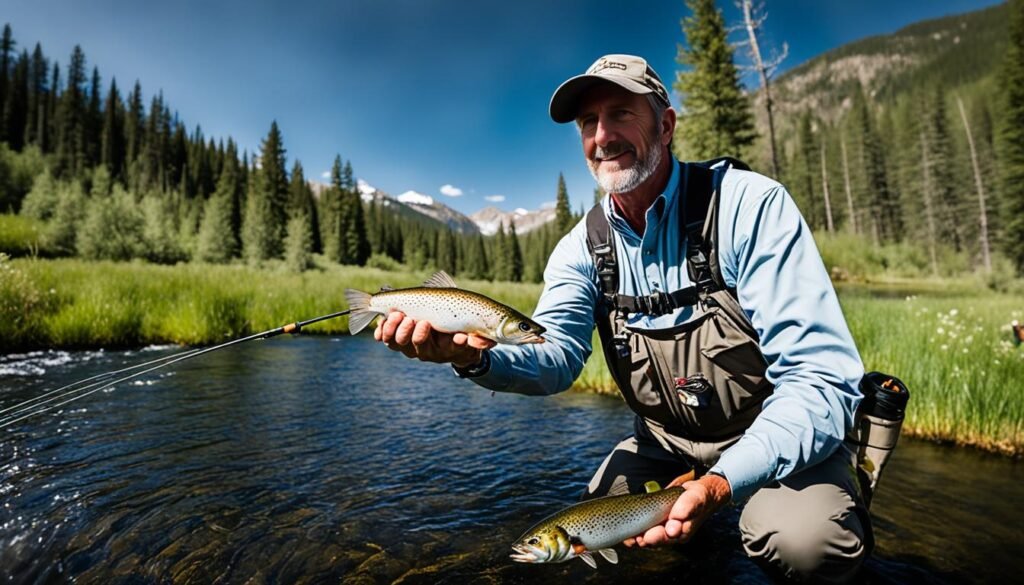
How to determine if flies are weighted properly?
When it comes to fishing with weighted flies, it’s crucial to ensure they are properly balanced for optimal success. Determining the correct weight of your flies can greatly improve your fishing strategy. Here are some clues and techniques to help you determine if your flies are weighted properly:
1. Observing Fly Behavior
One way to determine if your flies are properly weighted is by observing their behavior in the water. If your flies are frequently hooking the bottom or not touching the bottom at all, they may be too light. Ideally, your flies should drift naturally with the current, mimicking the movement of real insects.
2. Reading the Sighter
The sighter, a brightly colored section of your leader or indicator, can provide valuable information about the depth and behavior of your flies. By closely watching the sighter, you can notice any subtle movements or deviations that indicate if your flies are properly weighted. Adjusting the weight of your flies may be necessary if the sighter behaves erratically or fails to show any movement.
3. Assessing the Water and Fish
Understanding the water conditions and the behavior of the fish you’re targeting is crucial in determining the proper weight of your flies. If the fish are actively feeding near the bottom, your flies should have enough weight to reach that depth. Conversely, if the fish are suspended in the water column, lighter weighted flies that drift just above the bottom may be more effective.
4. Making Adjustments
If you determine that your flies are not properly weighted, adjustments can be made to achieve the desired presentation. Changing the size of the bead on your fly or adding a second fly can help increase or decrease the weight as needed. Experimenting with different bead sizes and fly combinations can allow you to fine-tune your presentation and maximize your chances of success.
It’s important to note that fishing with properly weighted flies is an advanced skill that comes with experience. As you gain more knowledge and practice, you’ll develop a better sense of how different weights affect the behavior of your flies and the overall success of your fishing outings.
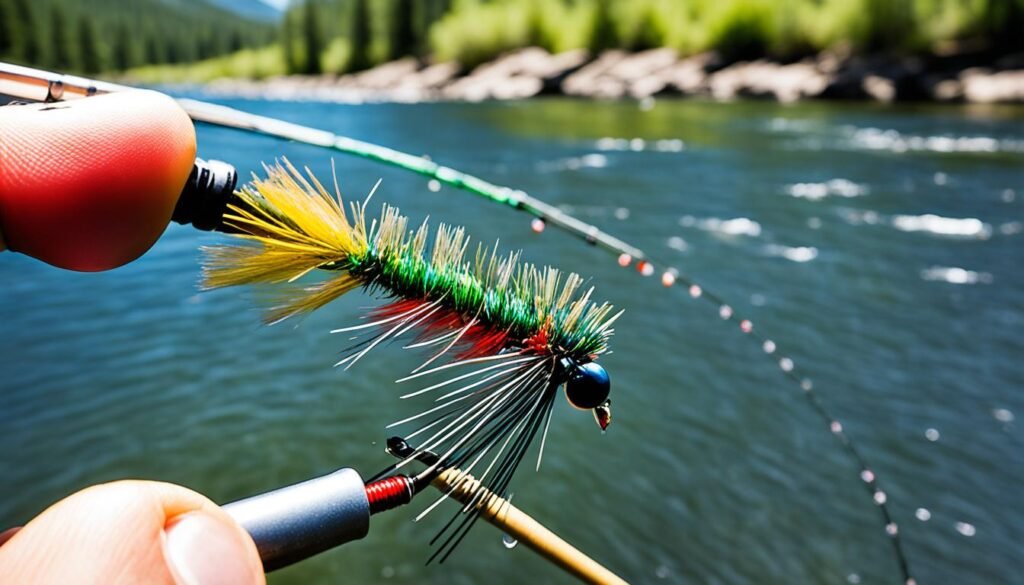
Advantages of nymphing without a strike indicator.
Nymphing without a strike indicator offers several advantages that can enhance your fly fishing experience. By removing the indicator from your nymphing setup, you can employ a stealthier approach that reduces the chances of spooking fish. This increases your chances of success, as the fish are less likely to be alerted to your presence.
Furthermore, nymphing without a strike indicator allows for a more natural drift of your flies. Instead of relying on the indicator to detect strikes, you learn to rely on your senses and feel the subtle movements and tugs from the fish. This heightened sensitivity gives you better control over detecting strikes and ensures a more effective hook set.
Another advantage of nymphing without a strike indicator is the ability to easily adjust the depth of your flies. Rather than having to reposition or change your indicator, you can simply raise or lower your rod tip to change the depth. This flexibility allows you to quickly adapt to changing water conditions and increase your chances of presenting the flies at the desired depth.
To summarize, nymphing without a strike indicator provides the following advantages:
- Stealthier approach for avoiding spooking fish
- More natural drift of flies for increased success
- Improved control and sensitivity in detecting strikes
- Easily adjustable fly depth for precise presentations
By embracing this technique, you can elevate your nymphing skills and experience the thrill of successfully fooling trout in their natural habitat.
| Advantages | Description |
|---|---|
| Stealthy Approach | Absence of a strike indicator reduces fish spooking |
| Natural Drift | Enhances the presentation for better success |
| Control and Sensitivity | Better ability to detect strikes and set the hook |
| Adjustable Depth | Quickly adapt to different water conditions |
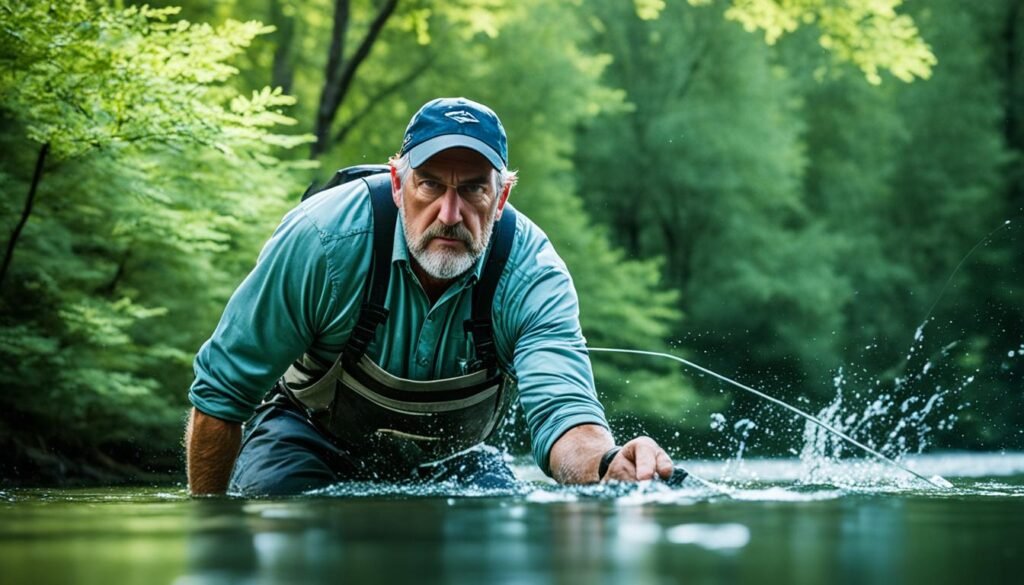
Techniques for successful nymphing without a strike indicator.
Mastering nymphing without a strike indicator requires employing specific techniques to increase your chances of success. Here are some tips to help you navigate this advanced nymphing strategy:
- Start with a dry dropper setup to test if the fish are willing to take a dry fly. This allows you to identify if the fish are feeding on the surface before switching to subsurface nymphs.
- If the fish aren’t responding to dry flies, switch to using one or two lightly weighted nymphs. These nymphs will mimic the natural behavior of insects and enhance your chances of enticing a bite.
- Adjust the depth of your nymphs by raising or lowering the rod tip. This technique allows you to present your flies at different levels in the water column to target fish at varying depths.
- Utilize a tight line technique to maintain a direct connection and feel for your flies. This means keeping a tight line between the rod tip and the flies, ensuring immediate reaction time when a fish strikes.
- Vary your nymph patterns based on the insects present in the water. By matching the hatch and imitating the most realistic patterns, you increase your chances of fooling the trout and enticing a bite.
By incorporating these techniques into your nymphing setup, you’ll be well-equipped to entice more strikes and improve your success rate on the water.
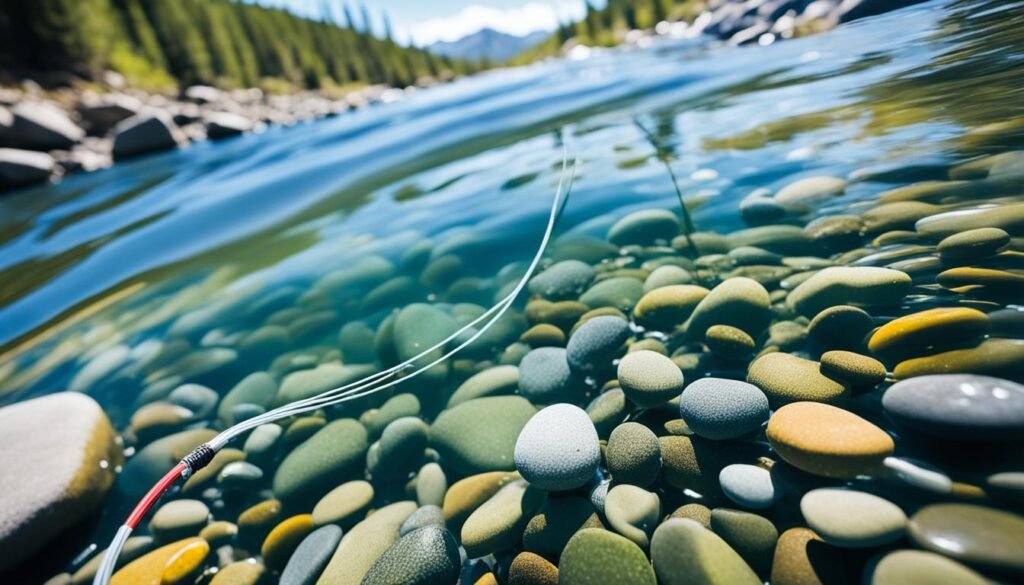
Lorem ipsum dolor sit amet, consectetur adipiscing elit. Vestibulum eleifend ultricies ex vitae dapibus. Aenean consequat dictum dui eu scelerisque. Vivamus auctor consequat velit, id ultrices turpis commodo ac.
The importance of reading the indicator.
When nymphing without a strike indicator, the sighter becomes an important tool for detecting strikes. The sighter should be set at a high enough position to be easily readable. It should maintain a specific angle to detect any tightening or twitching. Anglers should keep their eyes on the sighter at all times, as trout can take the nymph with a light and subtle pull. Striking at the first sign of movement is crucial.
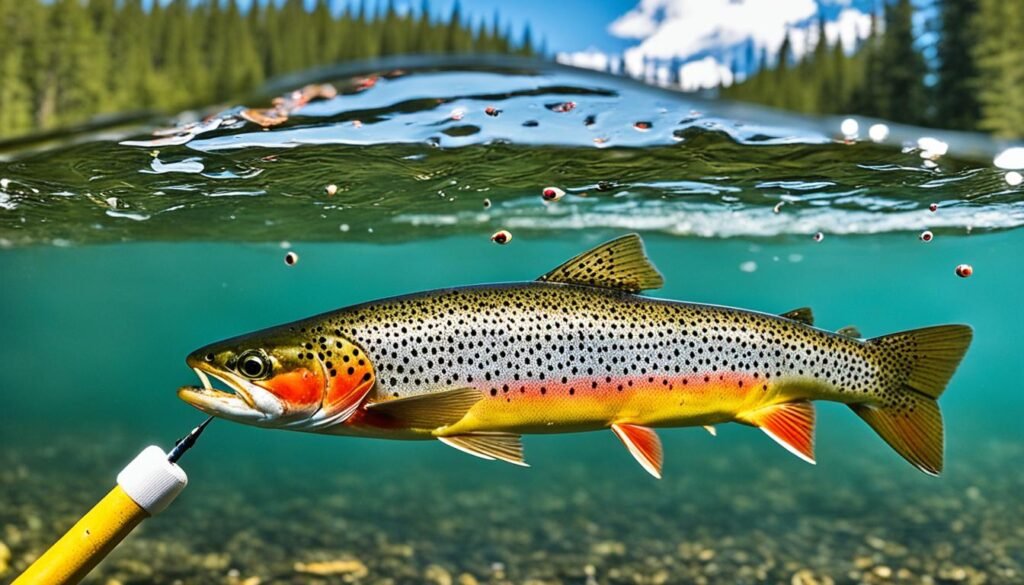
The Sighter Angle
Setting the sighter at the right angle is essential for effectively reading the indicator. The sighter should be positioned at an angle that allows for clear visibility and sensitivity to any movement. A slight bend or twitch in the sighter might signal a strike from a trout. Keeping a close eye on the sighter increases the chances of detecting subtle strikes and ensures a timely response.
Reading Trout Behavior
Understanding trout behavior is key to successfully interpreting the sighter’s movements. Trout may take the nymph with a gentle sip or a quick dart. By observing the sighter closely, anglers can gauge the intensity and duration of its movements. Reading these subtle cues will enable anglers to strike at the appropriate time, maximizing their chances of hooking the trout.
“By observing the sighter closely, anglers can gauge the intensity and duration of its movements.”
Being attentive to the sighter is crucial as trout behavior can vary depending on factors such as water temperature, feeding patterns, and the presence of other food sources. Each trout’s behavior may differ, so it is essential to pay attention and react accordingly to the sighter’s movements.
| Indicator Reading | Trout Behavior |
|---|---|
| Subtle twitch or hesitation | Trout taking the nymph with a gentle sip |
| Sudden jerk or aggressive movement | Trout striking the nymph with a quick dart |
| No movement | Trout not interested in the nymph or already hooked |
Advantages of tightline nymphing.
Tightline nymphing is a highly effective technique that offers several advantages for fly fishermen. By maintaining a direct connection between the angler and the flies, tightline nymphing allows for immediate detection and better hookups. This close connection provides a heightened sensitivity to even the subtlest strikes, improving your chances of landing more fish.
One of the key benefits of tightline nymphing is the ability to make more drifts. With the direct line of contact, you have better control over the depth and speed of the drift, allowing for a more precise presentation. This increased control enables you to keep your flies in the strike zone for longer periods, maximizing your opportunities for hookups.
Furthermore, tightline nymphing enhances your overall fishing experience by improving your ability to detect strikes and feel the slightest movement. The direct connection between the angler and the flies eliminates any slack in the line, allowing for instant transmission of even the subtlest vibrations. This heightened sensitivity enhances the angler’s ability to detect strikes and react accordingly, resulting in better hookup rates.
By utilizing the tightline nymphing technique, you can increase your chances of success on the water. The direct connection, improved control, and enhanced sensitivity to strikes all contribute to a more effective and enjoyable fishing experience. Whether you’re targeting wary trout or other freshwater species, tightline nymphing is a technique worth mastering.
Using multiple fly patterns.
Trout can be quite selective when it comes to fly patterns, so it’s essential for anglers to have a wide variety of options in their fly boxes. Choosing the right fly pattern can make a significant difference in enticing trout to strike. Understanding the preferences of the trout and imitating the most realistic patterns can greatly increase your chances of success on the water.
When selecting fly patterns, it is crucial to consider the local insect population and the seasonality of the flies. Different fly patterns imitate various stages of insect life, such as nymphs, emergers, duns, and spinners. By observing and identifying the prevalent insects in the water, you can match your fly pattern to the natural food source, making your presentation more convincing to the trout.
Trout have distinct preferences for specific fly patterns based on their feeding habits and regional factors. For example, in some rivers, trout may prefer a specific mayfly or caddisfly pattern due to the abundance of these insects. Therefore, it’s important to research the local hatch charts and consult with knowledgeable anglers or local fly shops to determine the most effective fly patterns for your fishing destination.
Having a selection of different fly patterns in your fly box allows you to adapt to changing conditions and fish behavior. When one fly pattern isn’t producing results, you can switch to another that closely matches the natural insects in the water. It’s always beneficial to carry a range of sizes, colors, and profiles to experiment with and find the pattern that entices the most strikes.
Remember, trout can be unpredictable in their feeding behavior, and what works one day may not work the next. Don’t be afraid to experiment and try different fly patterns until you find the one that triggers a response from the trout.
Here is an example of a selection of fly patterns that can be effective for trout fishing:
| Fly Pattern | Description | Imitates |
|---|---|---|
| Elk Hair Caddis | A buoyant dry fly with an elk hair wing | Caddisflies |
| Pheasant Tail Nymph | A slender nymph pattern tied with pheasant tail fibers | Mayfly nymphs |
| Woolly Bugger | A versatile streamer pattern with a marabou tail and hackle | Baitfish |
| Blue Wing Olive | A small mayfly pattern with a blue-green body | Blue-winged olive mayflies |
| Hare’s Ear Nymph | A buggy nymph pattern with a hare’s ear dubbing body | Mayfly nymphs, stoneflies |
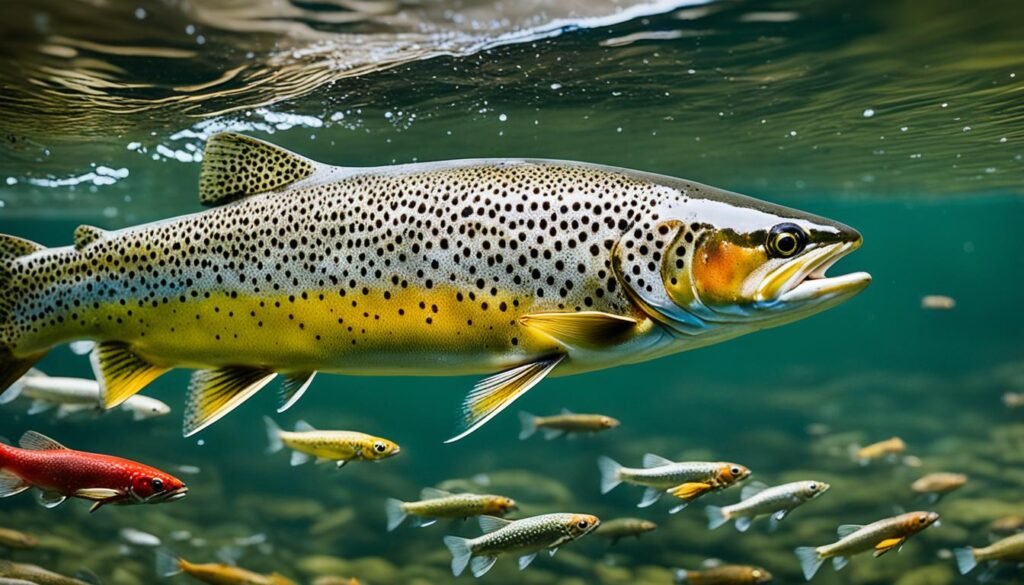
Exploring different nymph fishing techniques.
To improve your nymph fishing skills, it’s crucial to explore and learn different techniques. By expanding your repertoire, you can adapt to various environments and conditions, increasing your chances of success on the water. Below are some effective nymph fishing approaches to consider:
1. Using Droppers with Dry Flies
One popular technique is to incorporate droppers with dry flies. This involves attaching a nymph or emerger pattern to the hook bend of a dry fly, creating a two-fly setup. The dry fly serves as an indicator, floating on the water’s surface, while the nymph imitates a subsurface insect. This combination allows you to present your flies at multiple depths simultaneously, increasing your chances of enticing fish to strike.
2. European Nymphing
European nymphing techniques, such as Czech nymphing and Polish nymphing, have gained popularity among anglers worldwide. These methods involve using long, lightweight rods and thin, sensitive fly lines to detect subtle strikes. With European nymphing, you rely on the natural drift of your weighted nymphs as they sink in the current, keeping a tight line connection to feel even the slightest indication of a fish biting.
3. Fishing Without an Indicator
Fishing without a strike indicator requires honing your observation skills and relying on your instincts. By closely reading the water and watching for the slightest movement or interruption in the drift, you can detect strikes without the aid of an indicator. This technique allows for a more subtle and natural presentation, making it ideal for spooky trout or challenging fishing situations.
“By diversifying nymph fishing techniques, anglers can adapt to various scenarios and increase their chances of catching fish.”
Each nymph fishing technique has its advantages and can be effective in specific situations. By experimenting with these different approaches, you’ll be better equipped to tackle a variety of fishing conditions and increase your catch rate.
Remember, practice makes perfect, so take the time to refine your nymph fishing skills and discover which techniques work best for you.
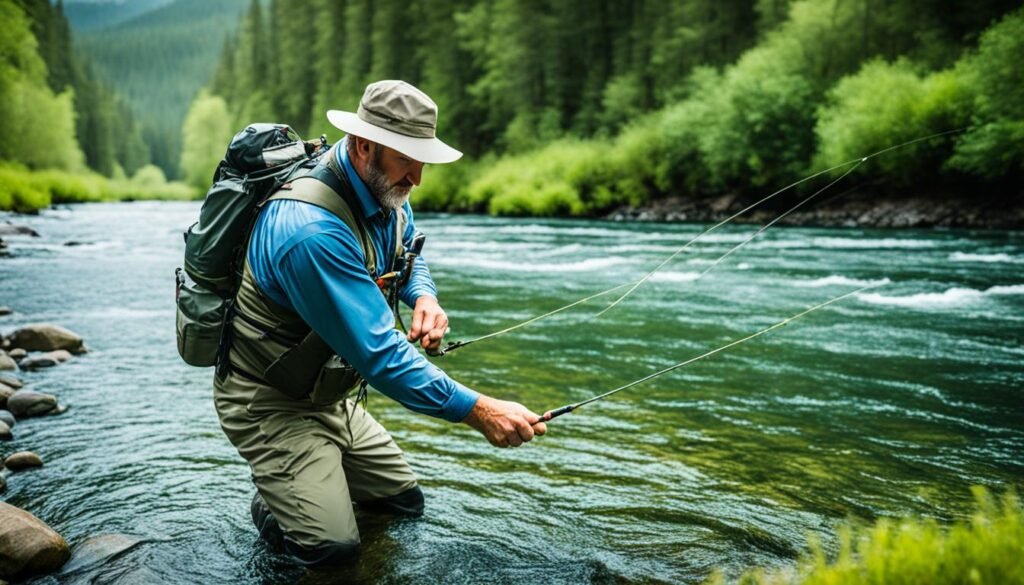
Continue reading Section 10 to learn valuable insights and tips to successfully master nymphing without a strike indicator.
Conclusion.
Mastering the art of nymphing without a strike indicator opens up a world of possibilities for fly fishermen. While it requires practice and experience, the benefits it offers are well worth the effort. By employing advanced nymphing techniques, anglers can enjoy a more successful and enjoyable fly fishing experience.
Nymphing without a strike indicator allows for a stealthier approach, reducing the chance of spooking fish and increasing the likelihood of a bite. The absence of an indicator also enables a more natural drift, mimicking the behavior of insects and enticing more fish to strike. With the ability to adjust the depth simply by raising or lowering the rod tip, anglers have greater control over their presentation and can better detect strikes.
With patience and persistence, anglers can become skilled and proficient in nymphing without a strike indicator. By understanding the advantages and techniques involved, they can unlock the full potential of this advanced nymph fishing technique. So, embrace the challenge, hone your skills, and get ready to catch more fish on your next fly fishing adventure.
FAQ
Why should I avoid fishing flies that are too heavy?
Fishing heavy flies can result in frequent hang-ups and make the fly look less natural. Lighter weighted nymphs that drift just off the bottom with the current mimic the natural behavior of insects and lead to more fish being caught.
How can I determine if my flies are weighted properly?
There are several clues to determine if the flies are weighted properly. If the flies are often hooking bottom or not touching the bottom at all, they may be too light. Reading the sighter, the water, and the fish are essential in determining the proper weight. Adjustments can be made by changing the bead size or adding a second fly.
What are the advantages of nymphing without a strike indicator?
Nymphing without a strike indicator allows for a stealthier approach, as the absence of an indicator reduces the chances of spooking fish. It also provides a more natural drift, resulting in more fish in the net. Without an indicator, anglers can adjust the depth of their flies simply by raising or lowering their rod tip. This technique also allows for better control and sensitivity in detecting strikes.
What are some techniques for successful nymphing without a strike indicator?
Start with a dry dropper setup to see if fish are willing to take a dry fly. If not, switch to using one or two lighter weighted nymphs. Adjust the depth by raising or lowering the rod tip. Use a tight line technique to maintain a direct connection and feel for the flies. Vary nymph patterns based on the insects present in the water.
Why is reading the sighter important when nymphing without a strike indicator?
The sighter becomes an important tool for detecting strikes when nymphing without a strike indicator. It should be set at a high enough position to be easily readable and maintain a specific angle to detect any tightening or twitching. Keeping your eyes on the sighter at all times is crucial, as trout can take the nymph with a light and subtle pull. Striking at the first sign of movement is crucial.
What are the advantages of tightline nymphing?
Tightline nymphing allows for immediate detection and better hookups due to the direct connection between the angler and the flies. It also enables the angler to make more drifts, increasing the chances of catching fish. With tightline nymphing, the angler has better control over the depth and speed of the drift, resulting in a more effective presentation.
How important is it to use multiple fly patterns when nymphing?
Trout can be picky when it comes to fly patterns, so it’s important to have a variety of options. The angler should choose fly patterns based on the local insect population and the seasonality of the flies. Understanding the preferences of the trout and imitating the most realistic patterns can greatly increase success. Having a selection of different fly patterns allows the angler to adapt to changing conditions and fish behavior.
What are the benefits of exploring different nymph fishing techniques?
To improve nymph fishing skills, it’s important to explore and learn different techniques. This allows anglers to adapt to different environments and conditions. Some techniques to consider are using droppers with dry flies, European nymphing, and fishing without an indicator. Each technique has its advantages and can be effective in specific situations. By diversifying nymph fishing techniques, anglers can increase their chances of catching fish.
Can I nymph without a strike indicator as a beginner?
Nymphing without a strike indicator requires practice and experience, but it can lead to more success and a more enjoyable fly fishing experience. By understanding the advantages and techniques of nymphing without a strike indicator, anglers can become more skilled and proficient in this advanced nymph fishing technique. With patience and persistence, anglers can master nymphing without a strike indicator and catch more fish.

